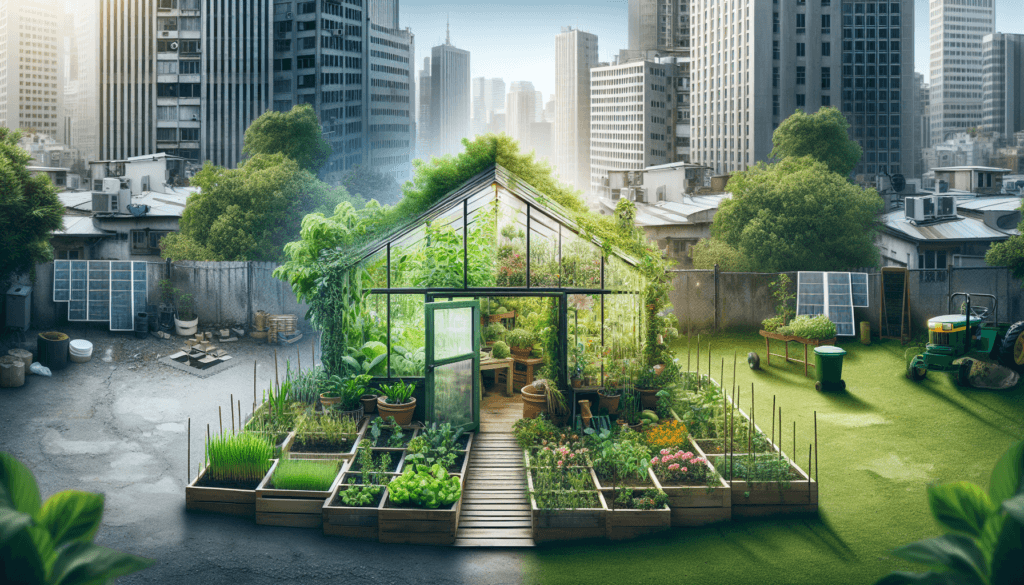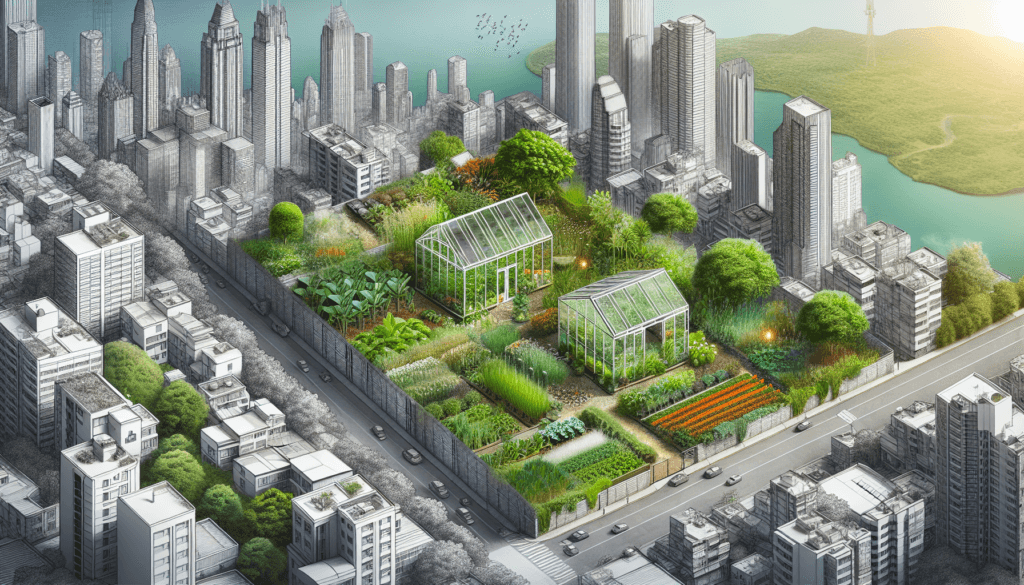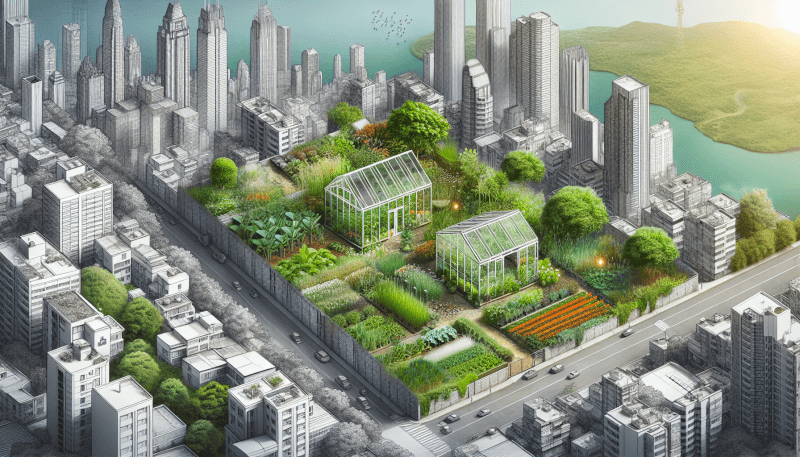Imagine transforming your small urban yard into a vibrant oasis, teeming with thriving plants and a source of fresh vegetables and vibrant flowers all year round. In this article, you will discover an easy, step-by-step guide on how to build your very own greenhouse in a small urban yard. From selecting the perfect location to choosing the right materials, this comprehensive guide will empower you to create a green thumb haven right in the heart of the city. Get ready to embark on a rewarding journey of cultivating your own sustainable paradise!
Choosing the Right Location
Assessing available space
When choosing the location for your greenhouse, it’s important to assess the available space in your small urban yard. Consider the dimensions and layout of your yard to determine where the greenhouse can fit comfortably without overwhelming the space. Take into account any existing structures or trees that may need to be taken into consideration when planning the greenhouse’s size and layout.
Considering sunlight exposure
Sunlight exposure is crucial for the health and productivity of the plants in your greenhouse. Select a location that receives ample sunlight throughout the day. Observe the path of the sun in your yard and choose a spot where the greenhouse will have maximum exposure to the sun’s rays. This will promote optimal growth and ensure that your plants receive the necessary amount of light.
Analyzing wind patterns
Wind can have a significant impact on the greenhouse’s stability and the well-being of your plants. Analyze the wind patterns in your yard to select a location that offers some protection from strong winds. Consider nearby structures or fences that can provide a natural windbreak, and choose a spot that minimizes exposure to prevailing winds. This will help prevent damage to the greenhouse and maintain a favorable microclimate for your plants.
Evaluating temperature variations
Temperature variations can greatly affect the success of your greenhouse. Assess the temperature patterns in your yard throughout the year to choose a location that minimizes extremes. Avoid areas that are prone to significant temperature fluctuations, such as near concrete surfaces or large reflective structures. Selecting a spot that maintains a relatively stable temperature will create a more consistent growing environment for your plants.
Determining the Greenhouse Size and Type
Selecting an appropriate size
Once you have chosen the ideal location, it’s time to determine the size of your greenhouse. Consider the available space in your yard and the desired capacity of your greenhouse. Assess the types of plants you intend to grow and their space requirements. If you have limited space, consider a smaller greenhouse that maximizes vertical growing. However, if you have ample space, you can opt for a larger greenhouse that allows for more diverse plantings.
Understanding different greenhouse types
There are various types of greenhouses to choose from, each with its own advantages and considerations. Research the different types, such as lean-to, gable, or quonset, to identify which one best suits your specific needs. Consider factors such as construction complexity, aesthetics, and functionality. Understanding the pros and cons of each type will help you make an informed decision for your small urban yard.
Deciding on a structure: Attached or freestanding
When deciding on the structure of your greenhouse, you have the option of an attached or freestanding design. An attached greenhouse shares a wall with an existing structure, such as your house or garage. This type of greenhouse can take advantage of existing utilities and provide convenient access. On the other hand, a freestanding greenhouse offers more flexibility in terms of design and placement. Consider your yard’s layout, aesthetics, and convenience factors to determine whether an attached or freestanding greenhouse is the best fit for your small urban yard.

Preparing the Site
Clearing the area
Before starting the construction of your greenhouse, it’s crucial to clear the area of any obstructions. Remove any plants, trees, or debris that may hinder the construction process or impede the growth of your plants inside the greenhouse. Clearing the area will provide a clean canvas for building your greenhouse and ensure optimal conditions for your plants.
Leveling the ground
A level ground surface is essential for the stability and proper functioning of your greenhouse. Ensure that the site is leveled by removing any bumps or uneven areas. Use a shovel or a rake to level the ground and create a smooth and even surface. This will prevent any water runoff and ensure that the greenhouse is structurally sound.
Installing a foundation or base
Depending on your greenhouse’s design, you may need to install a foundation or base to provide additional support and stability. Follow the manufacturer’s recommendations for your chosen greenhouse type to determine if a foundation is necessary. A foundation can help distribute the weight of the greenhouse evenly and protect it from shifting or settling over time. Consider options such as concrete, gravel, or treated wood for your greenhouse’s foundation, ensuring it is properly constructed and level.
Choosing the Greenhouse Materials
Considering the frame material
The frame material of your greenhouse plays a crucial role in its overall durability and longevity. Common frame materials include wood, aluminum, and galvanized steel. Each material has its own advantages and considerations. Wood is aesthetically pleasing and provides excellent insulation but requires regular maintenance. Aluminum is lightweight and resistant to rust but may not be as sturdy as other materials. Galvanized steel is durable and long-lasting but may be more expensive. Consider factors such as budget, climate, and personal preference when selecting the frame material for your greenhouse.
Selecting glazing options
Glazing refers to the material that will cover the greenhouse and allow sunlight to enter while providing insulation. Common glazing options include glass, polycarbonate, and polyethylene. Glass is a traditional choice that offers excellent visibility and longevity but can be heavy and fragile. Polycarbonate is lightweight, provides good insulation, and is shatterproof but may discolor over time. Polyethylene is affordable, easy to install, and provides adequate insulation but may need to be replaced more frequently. Consider factors such as climate, budget, and desired insulation properties when selecting the glazing material for your greenhouse.
Evaluating insulation choices
Insulation is essential to maintain a consistent temperature inside your greenhouse, especially in colder climates. Evaluate insulation choices such as bubble wrap, double-walled glazing, or insulation panels to enhance the energy efficiency of your greenhouse. Proper insulation can reduce heat loss and prevent temperature fluctuations, allowing your plants to thrive throughout the year. Consider the climate in which you reside and your greenhouse’s specific needs when choosing the most suitable insulation option.

Building the Greenhouse Frame
Constructing the base framework
Start building your greenhouse frame by constructing the base framework. This will provide the foundation for the rest of the structure. Follow the manufacturer’s instructions or your chosen greenhouse design to assemble the base framework using the appropriate materials. Ensure that the base is level and secure to promote stability and longevity. This is a critical step, as the base framework will be the backbone of your greenhouse structure.
Assembling the walls
Once the base framework is in place, assemble the walls of your greenhouse. Depending on the type of greenhouse you have chosen, this may involve attaching panels, setting up support beams, or connecting pre-made wall sections. Follow the manufacturer’s guidelines or your chosen design to ensure proper assembly. Take care to align the walls correctly and secure them tightly to create a sturdy and well-insulated greenhouse.
Installing the roof structure
After the walls are in place, it’s time to install the roof structure. This step may involve attaching trusses, beams, or purlins, depending on your chosen design. Follow the instructions carefully to ensure the roof structure is properly assembled and securely fastened. A well-built roof structure will provide support for the glazing and protect your plants from the elements. Take your time during this step to ensure the integrity of your greenhouse’s overall structure.
Installing the Glazing
Choosing the appropriate glazing material
Select the appropriate glazing material based on your earlier considerations. Take into account factors such as durability, insulation properties, and your budget. Carefully measure the dimensions of your greenhouse’s walls and roof to ensure a proper fit for the glazing material. Consider consulting with an expert or researching the specific requirements for your chosen glazing material to ensure a successful installation.
Securing the glazing panels
After selecting the glazing material, it’s time to secure the glazing panels to the greenhouse frame. Follow the manufacturer’s instructions or consult reliable resources to learn the recommended installation techniques for your chosen glazing material. Take care to align and secure the panels properly to minimize any gaps that may allow air or moisture to enter the greenhouse. This will help maintain a stable and optimal growing environment for your plants.
Sealing the edges and joints
To further improve insulation and prevent water leakage, it is essential to seal the edges and joints of your greenhouse glazing. Use appropriate sealants or weatherstripping materials to seal any gaps or openings. This will help maintain airtightness, reduce heat loss, and prevent water intrusion. Pay attention to the corners, edges, and any areas where different glazing panels meet to ensure a proper seal.

Ventilation and Temperature Control
Installing vents and fans
Proper ventilation is vital for controlling temperature and humidity levels inside the greenhouse. Install vents and fans to facilitate air exchange and prevent overheating. Choose venting mechanisms that can be easily controlled or automated, such as ridge vents or louvers. Consider the size and design of your greenhouse when determining the number and placement of vents and fans. This will help create a well-ventilated environment that promotes healthy plant growth.
Adding a thermostat and temperature control system
To maintain optimal temperature conditions for your plants, consider adding a thermostat and temperature control system to your greenhouse. A thermostat will monitor the temperature and trigger appropriate adjustments, such as opening or closing vents, turning on fans, or activating other cooling or heating mechanisms. Depending on your budget and needs, you can opt for manual or automated temperature control systems. This will ensure that your plants are kept within their ideal temperature range and safeguard them from extreme conditions.
Considering shading options
In addition to ventilation and temperature control, it’s important to consider shading options to protect your plants from excessive sunlight and heat. Install shading mechanisms such as shade cloth, blinds, or retractable awnings to regulate the amount of sunlight entering the greenhouse. This can help prevent overheating and sunburn on delicate plants. Assess the sunlight exposure in your yard and the specific needs of your plants to determine the most suitable shading option for your greenhouse.
Setting up Irrigation and Watering Systems
Designing a watering plan
An effective watering plan is essential for maintaining optimal moisture levels and promoting healthy plant growth in your greenhouse. Consider the specific watering needs of your plants and design a plan that ensures consistent and efficient irrigation. This may involve setting up drip irrigation systems, sprinklers, or manually watering through hoses or watering cans. Take into account factors such as water source accessibility, plant spacing, and any water conservation measures you may want to implement.
Installing a water supply system
To facilitate your watering plan, install a water supply system in your greenhouse. This can include connecting hoses or pipes to a water source, setting up water tanks, or installing a rainwater collection system. Ensure that the water supply system is properly installed and equipped with appropriate valves and filters to prevent clogging and ensure the delivery of clean water to your plants.
Incorporating automatic irrigation
For added convenience and precision in watering your plants, consider incorporating automatic irrigation systems into your greenhouse. This can involve timers, sensors, or programmable controllers that manage the watering schedule and duration. Automatic irrigation systems help maintain consistent moisture levels and reduce the risk of overwatering or underwatering. Research different irrigation options and consult experts to determine the most suitable system for your specific needs.

Providing Lighting and Electricity
Determining lighting requirements
In some cases, supplemental lighting may be necessary to ensure optimal growth and productivity of your plants inside the greenhouse, especially during dark winter months. Determine the lighting requirements of your specific plants to assess whether additional lighting is needed. Consider factors such as light intensity, duration, and light spectrum to provide the appropriate supplemental lighting. LED grow lights are a popular choice due to their energy efficiency and ability to mimic natural sunlight.
Installing electrical outlets and fixtures
To support lighting and other electrical needs in your greenhouse, install electrical outlets and fixtures. Consider the layout and design of your greenhouse to determine the optimal locations for outlets, ensuring that they are easily accessible and properly grounded. Consult with a certified electrician to ensure the electrical installations adhere to safety standards and comply with local building codes. This will provide a safe and reliable electrical system for your greenhouse.
Maintenance and Upkeep
Regular cleaning and sanitizing
To ensure a healthy environment for your plants, regular cleaning and sanitizing of your greenhouse is essential. Remove any debris, fallen leaves, or dead plant materials regularly to prevent the buildup of pests and diseases. Clean the glazing material, including any vents or shading mechanisms, to maintain maximum light transmission. Sanitize the surfaces periodically, using appropriate cleaners or natural solutions, to prevent the spread of bacteria or fungi. Regular cleaning and sanitizing will help create an optimal growing environment and promote the overall health of your plants.
Inspecting for pests and diseases
Regular inspections for pests and diseases are crucial to catch and address issues before they can spread and cause significant damage. Monitor your plants closely for any signs of pests, such as insects or other unwanted organisms. Check for symptoms of diseases, such as wilting, discoloration, or abnormal growth. Implement appropriate pest control measures, such as organic pest repellents or biological control methods, to mitigate infestations. Promptly treat any diseases or infections to prevent them from affecting your entire greenhouse. Regular inspections and proactive measures will help maintain a healthy and thriving plant population.
Monitoring temperature and humidity levels
Continuously monitor the temperature and humidity levels inside your greenhouse to ensure ideal growing conditions for your plants. Use thermometers, hygrometers, or even automated monitoring systems to regularly assess the environmental parameters. Optimal temperature and humidity ranges depend on the specific plants you are growing, so consult reliable resources or seek expert advice for the recommended levels. Adjust ventilation settings, shading mechanisms, watering schedules, and heating or cooling systems as needed to provide the best environment for your plants. Regular monitoring will help you make informed adjustments and maintain optimal growing conditions.



